15 Keys to One Green Bottle.
N° 1: Sentabour
I remember one day, in the early 1990s, flying back from Britain to Marseille, and the pilot saying, ‘If you look out of the window to your right, you might spot Peter Mayle’s house.’ Such was the success of A Year in Provence, Mayle’s account of renovating the farmhouse he had bought in the village of Ménerbes, 30 000 feet below, that everyone craned their necks, speculating which of the specks it could be. The success was due in large part to Mayle’s humorous observations of local details, from unreliable builders to clandestine truffle-hunters, but the book also touched a chord amongst millions of people ready to buy into his vision of Provence as a Land of Cockaigne, the mythical earthly paradise where nothing will ever get in the way of happiness.
Well, I’ve had the good fortune to live in Provence for 25 years, and of course it isn’t quite as Mayle described. People here can be as crass and nasty as anywhere else – in fact, if Marine Le Pen’s share of the vote is anything to go by, they’re crasser and nastier than the national average. All the same, you’d have to be a terminal grump to deny that Provence is a pleasant place to live – and that’s putting it mildly. And like Ménerbes, many of the Provençal villages count among the most beautiful in France. Which brings me to a particular village that no one has ever visited: Sentabour.
No one has been to Sentabour for the simple reason that it doesn’t exist, except as imagined by me and my readers, based on the information I give them in One Green Bottle. Which in fact is very little: there are just two adjectives used in relation to Sentabour, sleepy and charming (though the surrounding countryside, inspiration for Cézanne, is referred to in rather more detail). From this, anyone who’s been to Provence and visited Lourmarin, say, or Gordes, will form a perfectly adequate personal image of Sentabour. And for others there’ll be the general idea of prettiness one associates with a ‘charming village’ in Provence.
In my own mind, though, Sentabour isn’t quite as postcard pretty as Lourmarin, Gordes or Peter Mayle’s Ménerbes. Magali Rousseau, the main character, wouldn’t want to live in a place overrun by tourists for several months of the year, a place she would no doubt see as rather too twee. And the Lubéron area of Provence, where all these villages can be found, rightly or wrongly has a reputation for being a place for la gauche caviar – champagne socialists – which isn’t her style at all. So when I imagined Sentabour, I was thinking of somewhere slightly more ordinary – less touristy and more ‘typical’, if such a word can be applied to a village in Provence. My initial idea was Ventabren, a small village about 15 kms west of Aix en Provence.
As you can see, Ventabren is indeed charming, though it receives very few tourists. In fact, apart from a church, a bar, and a single upmarket restaurant, it has little to attract them despite its picturesqueness. On the other hand, being close to Aix, Marseille and Marignane, where both the airport and the major local employer Eurocopter are located, Ventabren is an attractive spot to live if you work in the surrounding area.
Another reason I chose Ventabren was the running track, where Magali goes to get fit. I went there once as part of an ageing football team recruited among the staff of the Psychology Department of the University of Provence. Our opponents making no concessions to our creaking limbs and lack of breath, we were comprehensively thrashed. But the venue stuck in my mind and in the book is conveniently situated five or ten minutes from Magali’s house.
All the same, Ventabren is simply too small to be Sentabour, which has shops, café terraces, and a far greater level of activity. And for that, one has to turn to Trets. again not far from Aix, but to the east. With a population of 10,500, Trets is more than twice the size of Ventabren and, crucially, has a superette – a small town-centre supermarket – where Magali finds part-time work as a cashier.
The fictional village of Sentabour, then, is a composite of two real villages in Provence. That’s the beauty of writing: Magali can be simultaneously ten minutes away from the Spar in Trets and the running track in Ventabren. To the reader it doesn’t matter, as long as it’s plausible within the world created by the writer. And though I call this a ‘key’ to the book, it’s not essential to its understanding – it’s only a key in the sense of unlocking what lies behind its creation. What exactly ‘provençal village’ conveys depends on each reader’s experience – whether they’ve been to Provence or not, what pictures they’ve seen of the area. And that, in most cases, will be perfectly adequate – when it comes to evoking the charm of a village in Provence, there are many candidates to choose from.
NB: For a wide variety of topics related to France, see the All About France link up on the Lou Messugo blog.



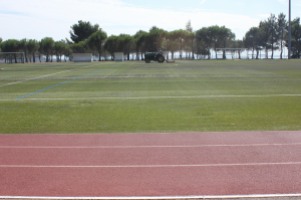
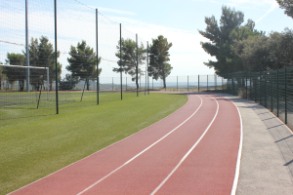
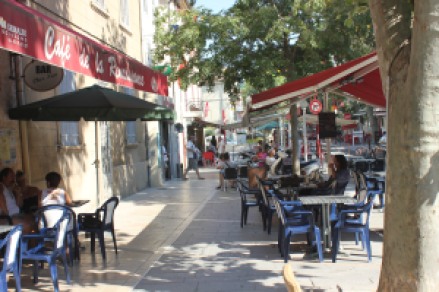
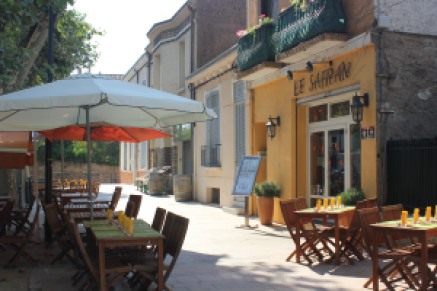
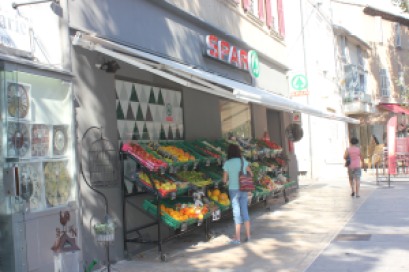

Sentabour, sleepy and charming, sounds like the imaginary Shangri-La kind of place, a fictional place described in the 1933 novel Lost Horizon by British author James Hilton. Such places only exist in the minds of literary folks, and even the ones similar to such imaginary places which existed on earth are getting converted into unsightly and dreary locales due to man’s never-ending gluttony (sigh)..!
Indeed. Luckily there are still some charming places to be found, but they’re certainly disappearing, as you say. Many thanks for dropping by to this site!
You’re welcome! The coming generations may spend their lives wandering the unending vastness of desert lands – sad and most unfortunate! 🙁
It’s great to get the inside thinking of a fictional writer and how you created Sentabour. I can just imagine it, living in Provence myself, visiting villages like this every day. Thanks for linking up to #AllAboutFrance, usually I don’t take so long to read and comment on links but the summer holidays and travel got the better of me! The next link up is this Thursday so I hope you’ll come back again. (Tip, the earlier you link up the more people tend to see and comment!)
Thanks, Phoebe! I’m preparing to return to Mayotte so may not make the next link up, but will keep it in mind for the following. Thanks for hosting, it’s a great way to connect.
This really is a great tip on inspiration and setting development.
Thank you! I always find it interesting to see where ideas come from.
Comments are closed.